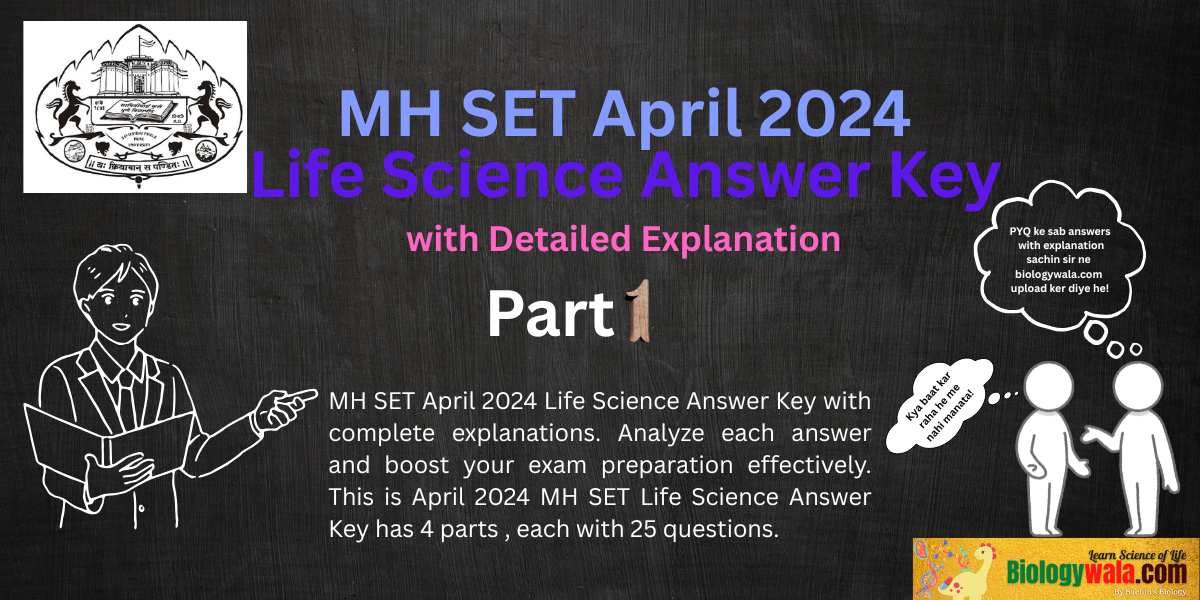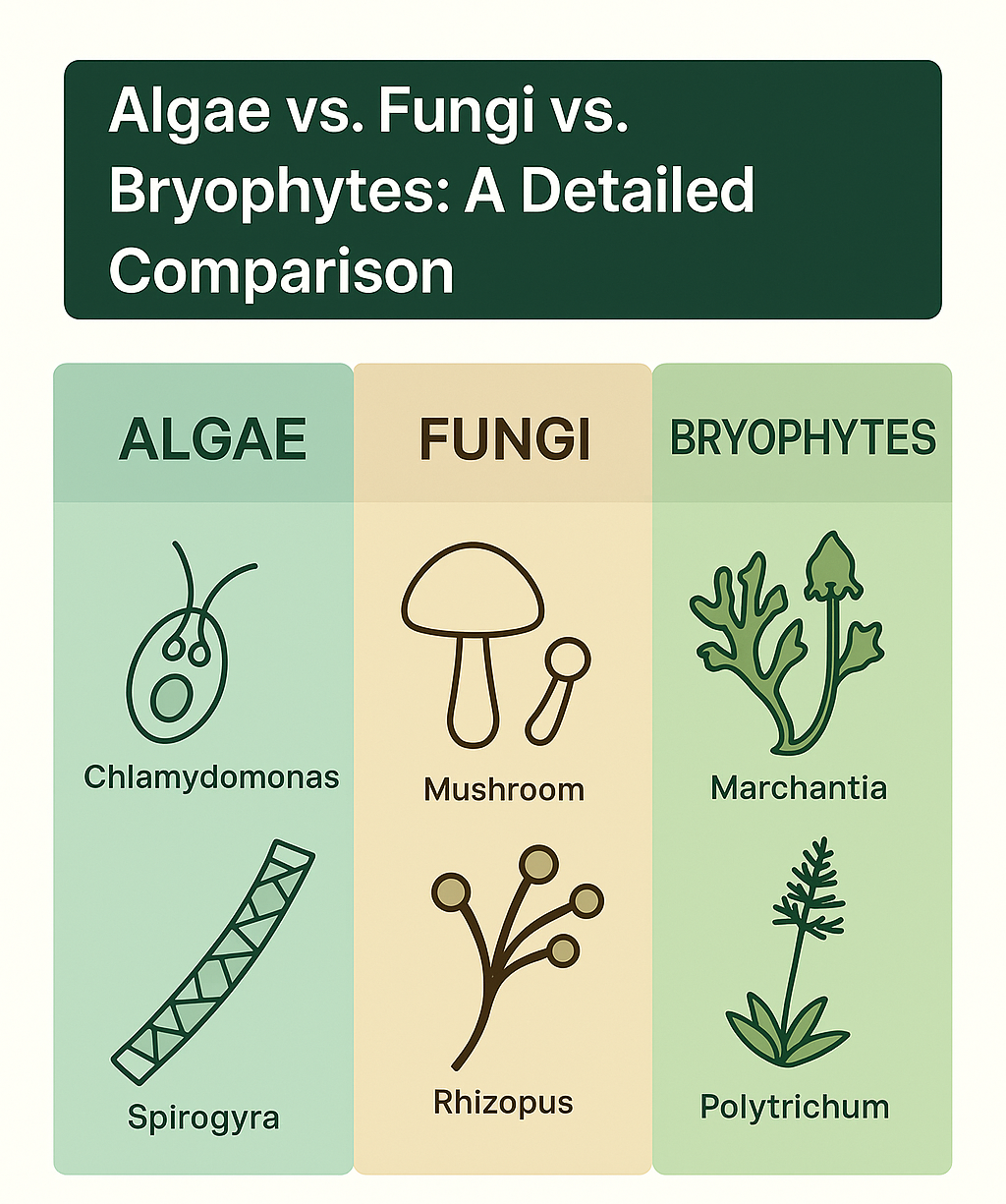MH SET April 2024 Life Science Answer Key with Detailed Explanation: Part 1

Download the MH SET April 2024 Life Science Answer Key with complete explanations. Analyse each answer and boost your exam preparation effectively.
Q.1 Hydrogen bonds are present in water structure. Presence of hydrogen bonds gives a characteristic property to water, which is :
(A) High melting and high boiling points
(B) High melting and low boiling points
(C) Low melting and high boiling points
(D) Low melting and low boiling points
Answer: (A) High melting and high boiling points
Explanation: Hydrogen bonds in water create strong intermolecular forces, which require more energy to break. This results in high melting and boiling points compared to other similar-sized molecules.
Q. 2 Which of the following membrane associated process involves the step of Clathrin coated vesicle formation during its mechanism ?
(A) Phagocytosis
(B) Amino acid uptake
(C) Receptor mediated endocytosis
(D) Calcium uptake
Answer : (C) Receptor-mediated endocytosis
Explanation: Clathrin-coated vesicles are key to receptor-mediated endocytosis, where specific molecules are internalized via receptors and clathrin helps form vesicles around them.
Q. 3 Which one of the following is not a part of cell theory ?
(A) Organism(s) are made up of cell(s)
(B) Cells are functional unit(s) of multicellular organisms
(C) Cells in a multicellular organism arise from preexisting cells
(D) Cells in a multicellular organism are derived from non cells
Answer : (D) Cells in a multicellular organism are derived from non-cells
Explanation: Cell theory states that all cells arise from pre-existing cells. Saying they come from “non-cells” contradicts this principle and is thus incorrect.
Q. 4 Assembly of cytoplasmic microtubule from the tubulin dimers is inhibited if the cell is treated with ………………
(A) Streptomycin
(B) Calmodulin
(C) Colchicine
(D) Carbenicillin
Answer : (C) Colchicine
Explanation: Colchicine binds to tubulin and inhibits microtubule polymerization, disrupting cell division and microtubule dynamics.
Q. 5 Prokaryotes may be characterised by :
(A) Presence of nucleus or nucleoid
(B) Absence of DNA
(C) Absence of membrane surrounding organells
(D) Presence of membrane around RNA
Answer : (C) Absence of membrane surrounding organelles
Explanation: Prokaryotic cells lack membrane-bound organelles such as nucleus, mitochondria, and ER, which is a defining feature distinguishing them from eukaryotes.
Q. 6 The following are the characteristics of which type of transposable element ? Simplest transposable element found in bacteria that encode transposase, with less than 5 kb size and with terminal inverted repeats that can transfer DNA directly is :
(A) Composite transposons
(B) Retrotransposons
(C) IS element
(D) Tn3-like elements
Answer : (C) IS element
Explanation: Insertion Sequence (IS) elements are the simplest transposable elements in bacteria, encoding only transposase and having terminal inverted repeats.
Q. 7 The first chromosomal linkage map for five genes on the X chromosome of Drosophila was constructed by :
(A) S. Benzer
(B) T.H. Morgan
(C) A.H. Sturtevant
(D) G.J. Mendel
Answer : (C) A.H. Sturtevant
Explanation: A.H. Sturtevant, a student of T.H. Morgan, created the first genetic linkage map using recombination frequencies in Drosophila.
Q. 8 A chromosomal site at which a group of genes affecting quantitative traits are located is called as :
(A) Qualitative trait locus
(B) Quantitative trait locus
(C) Multiple allele locus
(D) Dominant locus
Answer : (B) Quantitative trait locus
Explanation: A QTL (Quantitative Trait Locus) is a region of DNA that correlates with variation in a quantitative trait such as height or weight.
Q. 9 In prion disease, classically, the :
(A) Liver becomes excessively enlarged
(B) Liver becomes sponge like
(C) Brain ventricles are squeezed
(D) Brain becomes sponge like
Answer : (D) Brain becomes sponge like
Explanation: Prion diseases, like Creutzfeldt-Jakob disease, cause brain tissue to develop holes, leading to a sponge-like appearance and neurodegeneration.
MH SET April 2024 Life Science Answer Key with Detailed Explanation
Q. 10 Which one of the following is not a diversity index of living organism ?
(A) Shannon index
(B) Simpson index
(C) Berger-Parker index
(D) MPN index
Answer : (D) MPN index
Explanation: MPN (Most Probable Number) is a method to estimate microbial populations in water or food, not a biodiversity index like Shannon or Simpson.
Q. 11 Articulation of both the jaws with skull is termed as Jaw suspension. One of the following types is observed in the teleost fishes :
(A) Craniostylic
(B) Autostylic
(C) Holostylic
(D) Hyostylic
Answer : (B)
Q.12 In the representatives of order Cestoda, the mature proglottids get separated from main body by a process known as :
(A) Apoptosis
(B) Apolysis
(C) Homolysis
(D) Genolysis
Answer : (B) Apolysis
Explanation: Apolysis is the detachment of mature gravid proglottids from the tapeworm’s strobila (body), which then pass out to spread eggs.
Q.13 Taxonomic hierarchy refers to :
(A) Classification of species based on fossil record
(B) A list of taxonomists worked on taxonomy of a species
(C) A group of taxonomists who decide nomenclature of animals and plants
(D) Stepswise arrangement of all categories for classification of animals and plants
Answer : (D) Stepwise arrangement of all categories for classification of animals and plants
Explanation: Taxonomic hierarchy is the system of classifying organisms into a series of ranked categories like kingdom, phylum, class, order, etc.
Q. 14 Mycoplasmas, rickettsiae, and chlamydiae are :
(A) Types of fungi
(B) Small bacteria
(C) Species of protozoa
(D) Forms of viruses
Answer : (B) Small bacteria
Explanation: These are atypical, very small bacteria. Mycoplasmas lack a cell wall; rickettsiae and chlamydiae are obligate intracellular pathogens.
Q.15 When biological oxygen demand becomes very high ?
(A) The water becomes suitable for growth of aerobic microbes
(B) The amount of dissolved oxygen increases
(C) The water becomes anaerobic
(D) Both concentration of microbes and dissolved oxygen decreases
Answer : (C) The water becomes anaerobic
Explanation: High BOD indicates high microbial activity consuming oxygen, often depleting dissolved oxygen and creating anaerobic (low-oxygen) conditions.
Q.16 Which one of the following extra embryonic membrane found as unique feature in terrestrial vertebrates only ?
(A) Yolk sac
(B) Chorion
(C) Allantois
(D) Amnion
Answer : (D) Amnion
Explanation: The amnion is a fluid-filled sac that cushions and protects the embryo, unique to amniotes (reptiles, birds, mammals), enabling terrestrial reproduction.
Q.17 Since humans are having such a notable impact on the Earth and its life—a new, youngest epoch of the quaternary period is termed as :
(A) The Holocene
(B) The Paleocene
(C) The Anthropocene
(D) The Eocene
Answer : (C) The Anthropocene
Explanation: The Anthropocene refers to the current epoch where human activities significantly influence climate, biodiversity, and geology.
Q.18 What largest bacterium of > 600 µm size is known to inhabit the gut of Acantharus nigrofuscus ?
(A) Vibrio fischeri
(B) Spirillum volutans
(C) Epulopiscium fishelsoni
(D) Borrelia burgdorferi
Answer : (C) Epulopiscium fishelsoni
Explanation: Epulopiscium fishelsoni is one of the largest known bacteria, found in the intestines of surgeonfish, visible under light microscope.
Q.19 Heliophytes are the plants :
(A) Growing under shade
(B) Growing under direct sunlight
(C) Growing under waterlogged conditions
(D) Growing under saline conditions
Answer : (B) Growing under direct sunlight
Explanation: Heliophytes are sun-loving plants that thrive in high-light environments, often found in open fields or deserts.
Q. 20 The largest ‘carbon sink’ on the earth is :
(A) Forests
(B) Soils
(C) Oceans
(D) Animals
Answer : (C) Oceans
Explanation: Oceans absorb and store a large portion of Earth’s atmospheric CO₂, making them the largest carbon sink on the planet.
Q. 21 Nomenclature is governed by certain universal rules. Which one of the following is contrary to the rules of nomenclature ?
(A) The first word represents genus and second is a specific epithet
(B) The names are written in Latin and italicised
(C) Biological names can be written in any language
(D) When written by hand, names are to be underlined
Answer : (C) Biological names can be written in any language
Explanation: According to the universally accepted rules of binomial nomenclature: Names must be italicized (or underlined if handwritten). Therefore, option C is incorrect because scientific names must not be written in any language — only Latin is acceptable. Scientific names must be in Latin (or Latinized). The first word represents the genus, the second is the specific epithet.
Q. 22 Which among the following is functionally more diverse ?
(A) DNA
(B) RNA
(C) Protein
(D) Lipid
Answer : (C) Protein
Explanation:
Proteins perform a vast range of functions in the body, including:
- Enzymatic catalysis
- Transport (e.g., hemoglobin)
- Structural roles (e.g., collagen)
- Signaling (e.g., hormones like insulin)
- Immune responses (e.g., antibodies)
DNA and RNA mainly store and transfer genetic information. Lipids function in energy storage and membrane structure, but proteins are the most functionally diverse molecules.
Q. 23 River blindness disease occurs due to :
(A) Loa loa
(B) Mansonella perstans
(C) Mansonella streptocerca
(D) Onchocerca volvulus
Answer : (D) Onchocerca volvulus
Explanation:
Onchocerca volvulus is a parasitic filarial worm transmitted by the bite of blackflies. It causes onchocerciasis, also known as river blindness, due to severe itching, skin nodules, and eye damage leading to blindness.
Q. 24 Cridu chat syndrome is caused due to which of the following ?
(A) Deletion of short arm of chromosome no. 5
(B) Translocation of long arm of chromosome no. 5
(C) Duplication of short arm of chromosome no. 5
(D) Inversion of short arm of chromosome no. 5
Answer : (A) Deletion of short arm of chromosome no. 5
Explanation:
Cri du chat (French for “cry of the cat”) syndrome is a genetic disorder caused by a deletion on the short arm (p arm) of chromosome 5. Affected infants often have a cat-like cry, intellectual disability, and developmental delays.
Q. 25 If the genotypes of a husband and a wife are IAIB, how many different genotypes and phenotypes are
possible among the blood types of their children.
(A) 2 genotypes : 3 phenotypes
(B) 3 genotypes : 4 phenotypes
(C) 4 genotypes : 3 phenotypes
(D) 4 genotypes : 4 phenotypes
Answer : (C) 4 genotypes : 3 phenotypes
Explanation:
Parental genotypes: IAIB × IAIB
Possible offspring genotypes:
- IAIA → Blood group A
- IAIB → Blood group AB
- IBIB → Blood group B
- IAIB (again) – already counted
Thus:
Phenotypes: A, B, AB = 3 phenotypes
Genotypes: IAIA, IAIB, IBIB, and one repeated = 4 genotypes
Next: MH SET April 2024 Life Science Answer Key with Detailed Explanation
- MH SET April 2024 Life Science Answer Key with Detailed Explanation: Part 2
- MH SET April 2024 Life Science Key with Explanation: Part 3 (Will be uploaded on 10th June 2025)
- MH SET April 2024 Life Science Answer Key Explanation: Part 4 (Will be uploaded on 11th June 2025)
MH SET Life Science Question Paper PDF Download
Read more:
Join SACHIN’S BIOLOGY on Instagram or Facebook to receive timely updates and important notes about exams directly on your mobile device. Connect with Mr. Sachin Chavan, the founder of Sachin’s Biology and author of biologywala.com, who holds an M.Sc., NET JRF (AIR 21), and GATE qualifications. With SACHIN’S BIOLOGY, you can have a direct conversation with a knowledgeable and experienced professional in the field of biology. Don’t miss out on this opportunity to enhance your exam preparation!
![[Download] Free 6th. Ed. Molecular Biology of The Cell Book PDF| Bruce Albert's Molecular Biology of The Cell book PDF 2 Download Bruce Albert's Molecular Biology of The Cell book PDF](https://biologywala.com/wp-content/uploads/2021/08/Red-Orange-Abstract-Modern-Shapes-General-Twitch-Banner-1-520x245.png)

